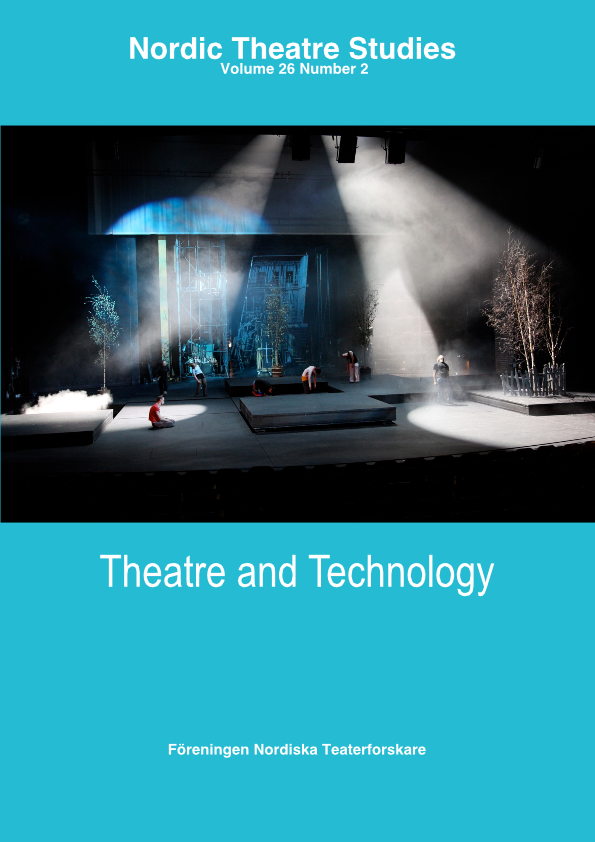From Candle Light to Contemporary Lighting Systems: How Lighting Technology Shapes Scenographic Practices
DOI:
https://doi.org/10.7146/nts.v26i2.24305Keywords:
scenography, lighting, theatre, technology, design, visualityAbstract
In this article, I discuss the influence of stage lighting on the processes of scenic design and the functioning of performance space. There has been a huge advance in lighting technology with regard to their accessibility, usability, luminosity and costs during the past decades. Light can no longer be thought of as a necessity that can just be added to the performance. It has become one of its basic visual elements, directing and focusing the spectators gaze. The rhythm of changing lighting cues create a visual dramaturgy, which has turned visual design from solid constructrions to a score of temporal events. Today you seldom see a performance without any use of projections or digital videos. I begin with a quick historical survey on the adaptation of electric light in order to exemplify the artistic significance of technological innovations. I move on to a more philosophical conversation about the metaphorical connotations of light as a basic component of the visual mise-en-scène. Then I return to the practices of contemporary theatre making and examine the contributions of the latest projection technology. I suggest that stage lighting has developed from being a technical tool making the scenes visible into a sovereign artistic agency creating images on its own terms. Today’s intermedial scenography can be seen as a parallel to the contemporary experience of our spatio-visual environment in everyday life, echoing the changes that happen in our ways of perceiving and conceptualizing the world.References
Arnold Aronson, ”One Hundred Years of Stage Lighting” in Looking into the Abyss. Essays on Scenography, The University of Michigan Press, Ann Arbor 2005.
Arnold Aronson, “Can Theater and Media Speak the Same Language” in Looking into the Abyss. Essays on Scenography, The University of Michigan Press, Ann Arbor 2005.
Christopher Baugh, Theatre, Performance and Technology. The Development of Scenography in the Twentieth Century, Palgrave Macmillan, Hampshire and New York 2005.
Edward S. Casey, The Fate of Place. A Philosophical History, University of California Press, Berkeley, Los Angeles, London 1998.
Freda Chapple, Chiel Kattenbelt, eds., Intermediality in Theatre and Performance, Rodopi, Amsterdam, New York 2006.
Edward Gordon Craig, ”The Actor and the Über-marionette” in Theatre and Performance Design. A Reader In Scenography, Jane Collins, Andrew Nisbet, eds., Routledge, London and New York, pp. 257-63. (First published in On the Art of the Theatre, Heinemann, London 1911)
Jonathan Crary, Techniques of an Observer. On Vision and Modernity in the Nineteenth Century, The MIT Press, Cambridge, Massachusetts and London 1990.
Tarja Ervasti, ed., Valovuosi, variaatiota valosta, DVD-publication of the exhibition of light design at the Theatre Museum in 2004, Helsinki 2009.
Laura Gröndahl, ”The Lighting Designer Is the Bassist of the Stage” in Theatre People – People’s Theatre, Kaisa Korhonen, Katri Tanskanen, eds., LIKE, Helsinki 2006.
Laura Gröndahl, ”Mitä lavastuksen tekniikka sanoo?” in Näkyvää ja näkymätöntä. Näyttämö ja tutkimus, Laura Gröndahl, Anna Thuring, Teemu Paavolainen, eds., Suomen teatterintutkimuksen seuran vuosikirja, no. 3, Helsinki 2009.
Laura Gröndahl, “Ai siitä tuli sitten tuollainen... Käytännön näkökulmia lavastusten syntyprosessiin”, in Näkyvää ja näkymätöntä. Näyttämö ja tutkimus, Laura Gröndahl, Anna Thuring, Teemu Paavolainen, eds., Suomen teatterintutkimuksen seuran vuosikirja, no. 3, Helsinki 2009.
Pamela Howard, What Is Scenography?, Routledge, London and New York 2002.
Martin Jay, Downcast Eyes. The Denigration of Vision in the Twentieth-Century French Thought, University of California Press, Berkeley, Los Angeles and London 1993.
Joslin McKinney, Philip Butterworth, The Cambridge Introduction to Scenography, Cambridge University Press, Cambridge 2009.
Tarmo Lemola, ed.,Näkökulmia teknologiaan, Gaudeamus, Helsinki 2000.
Karl-Erik Michelsen “Teknologian historia - tutkimuksen unohdettu ulottuvuus“ in Historia nyt, Pekka Ahtiainen et al., eds., WSOY, Helsinki 1990.
Pentti Paavolainen, Aino Kukkonen, Näyttämöllä. Teatterihistoriaa Suomesta, WSOY, Helsinki 2005.
Scott Palmer, Light, Palgrave Macmillan, Hampshire and New York 2013.
Heta Reitala, Suomalaista skenografiaa: lähtökohtia tallennukseen, tutkimukseen ja historiaan, Taideteollisen korkeakoulun julkaisusarja, Helsinki 1986.
Hannu Salmi, Atoomipommilla kuuhun, tekniikan mentaalihistoriaa, Edita, Helsinki 1996.
Oskar Schlemmer, ”Man and Art Figure” in The Theatre of the Bauhaus, Walter Gropius, Arthur S. Wensinger, eds., Wesleyan University Press, Middletown, Connecticut 1961.
Markku Uimonen, ”Mehr Licht? Warum?” in Valovuosi, variaatioita valosta, Tarja Ervasti, ed., DVD-publication of the exhibition of light design at the Theatre Museum in 2004, Helsinki 2009.
Downloads
Published
How to Cite
Issue
Section
License
The copyright belongs to the authors and Nordic Theatre Studies. Users can use, reuse and build upon the material published in the journal but only for non-commercial purposes. Users are allowed to link to the files, download the files, distribute the files on a local network (preferably by links), upload the files to local repositories if their institutions require them to do so, but not republish the files without proper agreements with the journal and the author.

